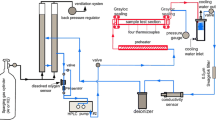Abstract
In this work, thermodynamic arguments for the stability of Ni and Cr compounds developed under pressurized water reactor environments (\(P_{H_2 O} \) and\(P_{H_2 } \)) were experimentally tested. A mechanism is proposed to explain crack initiation and propagation alloy 600 along the grain boundaries, where Cr2O3 has formed from the leaching of Cr from the matrix, leaving behind a porous Ni-rich region. The mechanism is based on the thermodynamic potential for the transformation of a protective NiO surface layer into an amorphous nonprotective Ni(OH)2 gel. This gel would also form along the grain boundaries and when hydrogenated steam reaches the porous Ni-rich regions. Crack initiation is then favored by tensile stressing of the grain boundary regions, which can easily rupture the gelatinous film. The leaching of matrix Cr to form nonprotective CrOOH gel at the crack tip followed by the exposure of fresh porous Ni to the environment could explain crack propagation in INCONEL alloy 600. The proposed crack initiation mechanism is not expected to occur in alloy 690 where a protective Cr2O3 film covers the entire metal surface. However, crack propagation along the grain boundaries in alloy 600 and precracked alloy 690 is expected to be active as hydroxide-forming reactions weaken the boundaries.
Similar content being viewed by others
References
T. Magnin, N. Renaudot, and F. Foct:Mater. Trans., JIM, 2000, vol. 41 (1), pp. 210–18.
J. Panteret al.:Corrosion, 2002, paper no. 02519.
L. Thomas and S. Bruemmer:Corrosion, 2000, vol. 56 (6), pp. 572–87.
G.P. Airey:Corrosion, 1979, vol. 35 (3), pp. 129–35.
J.-D. Mithieuxet al.:Eurocorr ’96, 1996, vol. IV/IX, pp. 2-1–2-4.
H.F. Lopez and J.B. Ferguson:SIF2004, Conf. Proc., September 2004, A. Atrenset al., eds., pp. 249–56.
S. Matshumima and Y. Shimizu:Trans. Jpn. Inst. Met., 1983, vol. 24 (3), pp. 149–53.
F. Foctet al.:Eurocorr ’96, 1996, vol. IV/IX, pp. 4-1–4-4.
C. Shen and P. Shewmon:Metall. Trans. A, 1990, vol. 21A, pp. 1261–71.
P. Scott:Corrosion, 2000, vol. 56 (8), pp. 771–82.
C. Giggins and F. Pettit:Trans. TMS-AIME, 1969, vol. 245, pp. 2495–507.
C. Giggins and F. Pettit:Trans. TMS-AIME, 1969, vol. 245, pp. 2509–14.
G. Calvarin, R. Molins, and A. Huntz:Oxid. Met., 2000, vol. 53 (1–2), pp. 25–48.
G. Calvarin, R. Molins, and A. Huntz:Oxid. Met., 2000, vol. 54 (1–2), pp. 399–426.
G. Calvarin-Amari, A. Huntz, and R. Molins:Mater. High Temp., 2001, vol. 18 (2), pp. 91–99.
T. Terachi, N. Totsuka, T. Yamada, T. Nakagawa, H. Deguchi, M. Horiuchi, and M. Oshitani:J. Nucl. Sci. Technol., 2003, vol. 40 (7), pp. 509–16.
S. Lozano-Perez and J. Titchmarsh:Mater. High Temp., 2003, vol. 20 (4), pp. 573–79.
Z. Szklarska-Smialowska, W. Lai, and Z. Xia:Corrosion, 1990, vol. 46 (10), pp. 853–60.
N.S. McIntyre, D.G. Zetaruk, and D. Owen:J. Electrochem. Soc., 1979, vol. 126 (5), pp. 750–60.
R. Rios, T. Magnin, D. Noel, and O. de Bouvier:Metall. Mater. Trans. A, 1995, vol. 26A, pp. 925–39.
M. Aia:J. Electrochem. Soc., 1966, vol. 113 (10), pp. 1045–47.
D. Wagman:J. Phys. Chem. Ref. Data, 1982, vol 11, Suppl., vol. 2, pp. 2–166.
M. Ali: Ph.D. Thesis, University of Wisconsin-Milwaukee, Milwaukee, WI, 2004, pp. 63 and 65.
N. Totuska, E. Lunarska, G. Grangnolino, and Z. Szklarska-Smialowska:Corrosion, 1987, vol. 43, pp. 505–14.
R.B. Rebak and Z. Szklarska-Smialowska:Corrosion, 1991, vol. 47, pp. 754–57.
T. Magnin:Corrosion-Deformation Interactions, Les Editions de Physique, Paris, France, 1993, pp. 27–41.
J.P. Hirth: inHydrogen Effects on Material Behavior, N.R. Moody and A.W. Thompson, eds., TMS, Warrendale, PA, 1990.
O. Knackeet al.:Thermochemical Properties of Inorganic Substances, Volumes I & II, 2nd ed., Springer-Verlag, New York, NY, 1991, pp. 503, 521, 803, 811, 1438, 1455, and 1493.
Author information
Authors and Affiliations
Rights and permissions
About this article
Cite this article
Ferguson, J.B., Lopez, H.F. Oxidation products of INCONEL alloys 600 and 690 in pressurized water reactor environments and their role in intergranular stress corrosion cracking. Metall Mater Trans A 37, 2471–2479 (2006). https://doi.org/10.1007/BF02586220
Received:
Issue Date:
DOI: https://doi.org/10.1007/BF02586220




